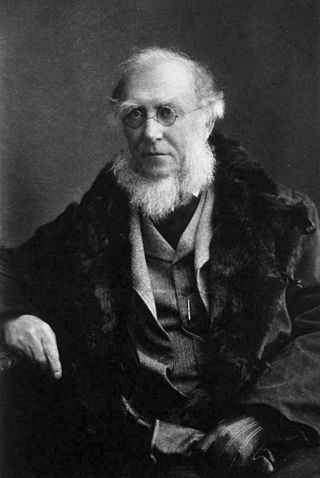
Sir Joseph Dalton Hooker was a British botanist and explorer in the 19th century. He was a founder of geographical botany and Charles Darwin's closest friend. For 20 years he served as director of the Royal Botanical Gardens, Kew, succeeding his father, William Jackson Hooker, and was awarded the highest honours of British science.

George Bentham was an English botanist, described by the weed botanist Duane Isely as "the premier systematic botanist of the nineteenth century". Born into a distinguished family, he initially studied law, but had a fascination with botany from an early age, which he soon pursued, becoming president of the Linnaean Society in 1861, and a fellow of the Royal Society in 1862. He was the author of a number of important botanical works, particularly flora. He is best known for his taxonomic classification of plants in collaboration with Joseph Dalton Hooker, his Genera Plantarum (1862–1883). He died in London in 1884.

Sir William Jackson Hooker was an English botanist and botanical illustrator, who became the first director of Kew when in 1841 it was recommended to be placed under state ownership as a botanic garden. At Kew he founded the Herbarium and enlarged the gardens and arboretum. The standard author abbreviation Hook. is used to indicate this person as the author when citing a botanical name.
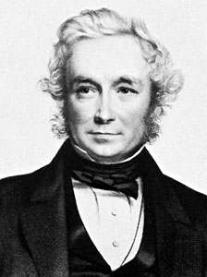
John Stevens Henslow was an English Anglican priest, botanist and geologist. He is best remembered as friend and mentor to his pupil Charles Darwin.
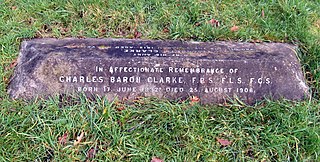
Charles Baron Clarke was a British botanist. He was born at Andover, the eldest son of Turner Poulter Clarke. He was educated at King's College School, London, and at Trinity and Queens' Colleges, Cambridge. He began the study of law at Lincoln's Inn in 1856 and was called to the bar in 1860. He lectured in mathematics at Presidency College, Calcutta, from 1857 to 1865. Clarke was Inspector of Schools in Eastern Bengal and later of India, and superintendent of the Calcutta Botanical Garden from 1869 to 1871.
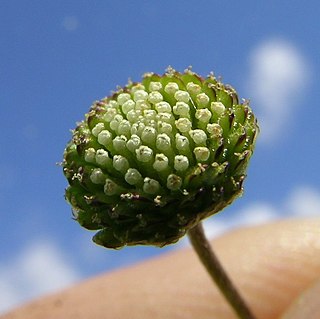
Cotula australis is a species of plant in the daisy family known by the common names bachelor's buttons, annual buttonweed, southern waterbuttons and Australian waterbuttons. This small plant is native to Australia and New Zealand, but it is known in other areas of the world as a common weed.

Pachystegia insignis is a species of flowering plants in the family Asteraceae. It is endemic to New Zealand.

Dracophyllum milliganii is a species of angiosperm in the family Ericaceae and the sub-family Epacridoideae. It is a distinctive alpine shrub, endemic to western Tasmania.

The Flora Antarctica, or formally and correctly The Botany of the Antarctic Voyage of H.M. Discovery Ships Erebus and Terror in the years 1839–1843, under the Command of Captain Sir James Clark Ross, is a description of the many plants discovered on the Ross expedition, which visited islands off the coast of the Antarctic continent, with a summary of the expedition itself, written by the British botanist Joseph Dalton Hooker and published in parts between 1844 and 1859 by Reeve Brothers in London. Hooker sailed on HMS Erebus as assistant surgeon.

The Ross expedition was a voyage of scientific exploration of the Antarctic in 1839 to 1843, led by James Clark Ross, with two unusually strong warships, HMS Erebus and HMS Terror. It explored what is now called the Ross Sea and discovered the Ross Ice Shelf. On the expedition, Ross discovered the Transantarctic Mountains and the volcanoes Mount Erebus and Mount Terror, named after each ship. The young botanist Joseph Dalton Hooker made his name on the expedition.
The Flora Tasmaniae is a description of the plants discovered in Tasmania during the Ross expedition written by Joseph Dalton Hooker and published by Reeve Brothers in London between 1855 and 1860. Hooker sailed on HMS Erebus as assistant surgeon. Written in two volumes, it was the last in a series of four Floras in the Flora Antarctica, the others being the Botany of Lord Auckland's Group and Campbell's Island (1843–1845), the Botany of Fuegia, the Falklands, Kerguelen's Land, Etc. (1845–47), and the Flora Novae-Zelandiae (1851–1853). They were "splendidly" illustrated by Walter Hood Fitch.
Pothos lancifolius is climbing plant species described by Hooker in the family Araceae. No subspecies are listed in the Catalogue of Life. This species has been recorded from Peninsular Malaysia and Vietnam - where it is called ráy leo lá rách or ráy leo hình bút lông.
Garcinia multiflora is a tree species in the family Clusiaceae. No subspecies are listed in the Catalogue of Life.

Cystacanthus is a genus of plant in the family Acanthaceae, found in south-east Asia.
Dalbergia parviflora is a species of liana found in South East Asia. Its name is kayu laka in Malay and Indonesian, khree in Thai, and in Vietnamese it is trắc hoa nhỏ. The heartwood of the plant is lakawood, an aromatic wood used for incense. The genus Dalbergia is placed in the subfamily Faboideae and tribe Dalbergieae; no subspecies are listed in the Catalogue of Life.
Disepalum is a genus of plants in the family Annonaceae and tribe Annoneae.
Aframomum cereum is a monocotyledonous plant species in the family Zingiberaceae that was first described by Joseph Dalton Hooker, and got its current name from Karl Moritz Schumann.
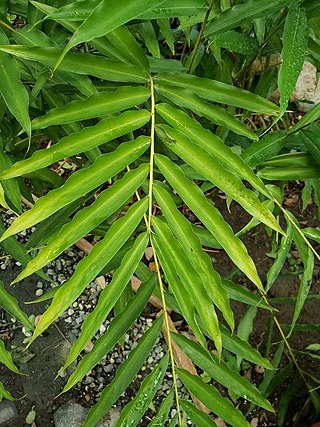
Aframomum daniellii, also known as African cardamom, is a species in the ginger family, Zingiberaceae. It was first described by Joseph Dalton Hooker, and got its current name from Karl Moritz Schumann.
Aframomum longiscapum is a species of plant in the ginger family, Zingiberaceae. It was first described by Joseph Dalton Hooker and got its current name from Karl Moritz Schumann.

Charles Samuel Pollock Parish (1822–1897) was an Anglo-Indian clergyman and botanist who served as chaplain to the forces of the Honourable East India Company in Burma. With his wife Eleanor he collected and painted plants, chiefly orchids, identifying and naming a number of species new to science. Several species are named in his honour.













